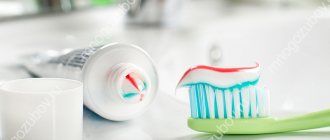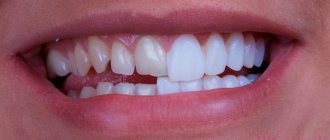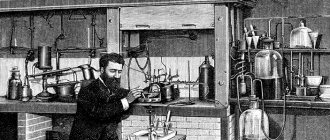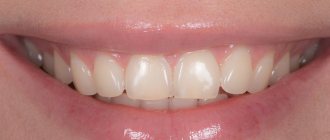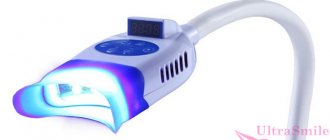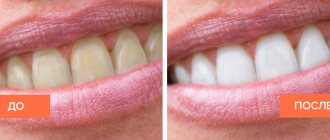What is the safest and most effective teeth whitening? Modern dentistry has quick transformation methods that can make your smile beautiful, your enamel strong, and your mucous membranes healthy. Almost all patients dream of a snow-white smile, because it adds confidence.
There are many ways to lighten the enamel layer. Each of them differs in the technology of processing hard tissues, efficiency, and speed of achieving results. They all have their advantages and disadvantages. Only a doctor can help you choose the best option.
Types of teeth whitening in dentistry
Professional teeth whitening involves performing procedures in a dental office and under the direct supervision of a specialist. In this case, mechanical or chemical effects may be exerted on the tooth enamel. The effectiveness of the latter can be enhanced by the penetrating ability of ultrasound, laser or light, which act as an activator and conductor for the reagent that penetrates deep into the enamel.
Today there are a number of popular whitening methods, each of which has its own advantages and disadvantages. Their descriptions will help you give preference to one or another procedure.
Risks
When choosing the type of procedure, patients are primarily interested in which teeth whitening is the safest. What are the dangers of lightening the enamel:
- increased sensitivity, thinning of the enamel layer, uneven shade;
- premature abrasion of hard tissues;
- increased fragility and fragility of teeth;
- irritation, burns of the mucous membranes of the oral cavity due to an incorrectly selected method.
Photobleaching
One of the “youngest” whitening methods. During its use, a special whitening gel is applied to the visible surface of the teeth, with a minimum concentration of hydrogen peroxide, which, under the direct influence of light emitted by a halogen lamp, is activated and penetrates deep into the enamel, while breaking down its pigment plaque. This procedure is often called ZOOM whitening, since the ZOOM-4 series device can be used for it. You can sign up for a whitening procedure using the ZOOM-4 device on our website
Advantages
- Quick visible effect.
- Suitable for patients with sensitive tooth enamel.
- If you follow the dentist's recommendations, the effect lasts up to 2 years.
Flaws
- The duration of the procedure is 1.5 – 2 hours in the dentist’s chair.
- Unpleasant taste in the mouth after the procedure.
- There may be an effect of “unnatural whiteness” of teeth, with a blue tint.
What methods of whitening are there and why are there so many of them?
Each manufacturer has its own classification, but simply, all whitening systems can be divided into two types:
- Office (or “clinical”) whitening, which is performed by a dentist in a clinic.
- At-home whitening designed to whiten your teeth yourself.
In-office teeth whitening systems
Office systems differ from home systems in having a higher concentration of bleaching agent (hydrogen peroxide or carbamide), so they whiten teeth quickly and significantly better.
Only a dentist can perform such whitening.
Bleaching systems differ in the method of activation of the bleaching composition:
- photochemical - activation with ultraviolet, LED lamp or laser light
- chemical (lampless) – activation due to a chemical reaction
If you need to get a snow-white smile QUICKLY , then you should choose in-office teeth whitening systems.
Home teeth whitening systems
At-home systems are most often used to maintain the results of in-office whitening and are offered as:
- trays that hold the whitening gel
- whitening strips , pencils and toothpastes
If in-office whitening is not recommended for medical reasons, professional at-home teeth whitening can be used. A course of home whitening will give an effect close to that in the office, but still not the same.
Philips offers two professional home teeth whitening systems, ZOOM DayWhite and NiteWhite.
Air Flow
This is a mechanical cleaning of enamel that effectively removes plaque and hard deposits (tartar) from the surface of teeth. To carry it out, Air flow sandblasting equipment is used, which supplies the enamel surface with a high-pressure stream consisting of water, an abrasive substance and air. Common soda crystals are used as an abrasive, destroying dental plaque and polishing enamel. Learn more about Air Flow teeth brushing.
Advantages
- During the procedure, tartar is removed, a common cause of caries.
- Ability to clean hard-to-reach places.
Flaws
- Lightening by only 2 - 3 tones.
- During the procedure, patients with sensitive enamel experience pain.
Methods for carrying out the procedure in a dental office
Restorative teeth whitening can be performed in several ways. Let's list them.
Direct method, when the doctor corrects defects directly in the patient’s mouth
In this case, restorative bleaching is carried out in just one visit to the clinic. In the process, the specialist removes plaque and grinds down the enamel a little (to level the surface and better adhesion of fabrics to artificial materials), and then applies layer-by-layer layers of composite (there can be 10 or more of them), which are then polymerized with a special lamp. The doctor achieves the required shade, forms the desired shape, position and size of the crown, and then carefully grinds and polishes the material.
The photo shows artistic restoration of teeth using composites.
This method appeals to a large number of patients, as it does not require serious financial investments. Moreover, the result of such restorative bleaching can be corrected at any time. But the direct method also has certain disadvantages:
- it is necessary that such exquisite work be performed by a professional doctor, otherwise you may be disappointed in the result obtained,
- The composite material is stained by food and drinks, and plaque deposits on it. In addition, the composite does not have the shine of natural enamel, so over time it becomes dull and needs to be polished. To maintain the restoration in good condition, you need to visit the dentist at least once every 3-4 months.
“I really hoped to whiten my front teeth, because there are dark spots on them, but the doctor categorically forbade it. He said that the spots are caused by a disease, and bleaching not only will not help me, but will further deteriorate the condition of the enamel, making it thinner and more sensitive. I was very upset and was going to get crowns, but the specialist suggested a less radical and more affordable measure, namely restorative bleaching with a composite. Without thinking twice, she agreed. Yes, the method has disadvantages, but it’s better than walking around with spots like mine. I can say that it’s definitely worth doing the procedure if you have a similar hopeless situation.”
Karine, review from otzovik.com
Indirect method, when the restoration is pre-created in the laboratory
In this case, it will not be possible to get by with just one visit to the doctor.
At the first stage, the specialist prepares the teeth that need restorative bleaching and takes impressions of the jaws. During the preparation process, it is necessary to cut down the enamel layer (usually 0.3 to 0.8 mm of tissue is removed, which depends on the thickness of the onlay chosen by the patient). During the production of restorations, the doctor covers the prepared tissues with caps that protect them from destruction, bacteria, temperature and hardness of food.
At the initial stage, dental impressions should be taken
At the second stage, the resulting impressions are sent to the laboratory, where technicians create thin onlays from materials such as composite, ceramic, ceramic composite, and zirconium dioxide. The waiting process for restoration overlays usually takes about 2-3 weeks.
Direct restorative teeth whitening is usually carried out by a dentist-therapist, but indirect restorations are carried out by an orthopedic surgeon.
At the third stage, in fact, restorative bleaching takes place, but in this case it would be more correct to call it microprosthetics. The specialist processes, disinfects and thoroughly dries hard tissues, after which he places the thinnest snow-white overlays on their surface, which are securely and permanently fixed with dental cement.
Installing veneers will help change the color, shape and size of teeth
Among the advantages of this method: durability (7-15 years or more), high level of aesthetics, preservation of the original color of the restoration throughout its entire service life, resistance to dyes from food and drinks, protection of sensitive enamel from bacteria, caries and destructive processes. But there is one significant drawback - the high price.
Chemical bleaching
The name of the method speaks for itself and involves applying a special chemical based on hydrogen peroxide to the visible surface of the teeth. Penetrating deep into the enamel, it destroys pigment molecules, and teeth become 4 to 10 shades lighter.
Advantages
- Quickly achieve the desired effect.
- A long-term result, which, if the recommendations are followed, can last for 1.5 years.
Flaws
- Tooth enamel becomes more sensitive.
- If the gums are poorly insulated during the procedure, they can get burned.
How is restorative bleaching performed?
The procedure takes place in several stages:
· select the desired shade of enamel;
· teeth are treated with a specialized brush and toothpaste;
· a bonding agent is applied, which has healing properties, makes the enamel less sensitive, and prevents the entry of bacteria.
Composite material is applied to the front part of the tooth;
· To create a radiant effect, the surface of the tooth is polished.
· Post-procedure care
To strengthen the result, after lightening you must follow some rules, this will help extend the service life of the plates:
· Take good care of your oral cavity;
· give up cigarettes;
· do not drink coloring drinks (red wine, soda, coffee, etc.);
· do not bite seeds, do not eat toffees and other sticky foods.
In addition, you need to regularly visit the dentist to monitor the condition of the plates.
Ultrasonic whitening
The use of ultrasound in combination with special pastes and gels based on oxidizing agents, which are pre-applied to the visible surface of the teeth, gives a fairly good result and will lighten the enamel by 2 - 3 tones.
Advantages
- The method is suitable for patients with sensitive tooth enamel.
- No pain.
Flaws
- To achieve maximum effect, several procedures will be required.
Whitening with a discount of 5000 rubles!
Moscow
Why is everything not as fast, effective and cheap as they promise in advertising!
Advertisements for any whitening systems talk about the safety, painlessness, speed, efficiency and affordability of the procedure, but do not pay due attention to proper preparation for teeth whitening.
Proper preparation takes time and may require additional financial investment.
The better the condition of your teeth, the less time and money it will take you to prepare for whitening.
Regardless of which whitening system you choose, the correct preparation is:
- will ensure the safety of whitening for teeth enamel
- will reduce the risk of pain during and after the procedure
- will give maximum whitening effect
Prepare properly for whitening and you will not be disappointed with the results.
Endobleaching
Endodontic lightening of tooth enamel (or as it is often called intracanal whitening) is a labor-intensive procedure that allows you to lighten pulpless teeth and teeth with cracks on the enamel surface. The problem is that, being damaged, they darken from the inside over time and a superficial effect on the enamel in this case does not have a positive effect. Therefore, to lighten them, a special whitening gel is introduced into the tooth cavity, followed by a filling.
Advantages
- The method allows you to lighten damaged teeth and enamel.
- Painless procedure.
- It is possible to lighten the enamel by 8 – 10 tones.
- You can lighten only one or two affected teeth.
Flaws
- Tooth tissues become more fragile.
- To achieve maximum effect, 2–4 procedures will be required.
First, oral health, and then the beauty of teeth!
Agree that snow-white teeth do not go hand in hand with caries, inflamed gums and bad breath. A wide, “dazzling” smile will not be enhanced by the absence of some teeth and pronounced orthodontic problems.
In general, first a healthy (sanitized) oral cavity, and only then whitening - as the final touch to a flawless smile!
Despite the fact that teeth whitening is a cosmetic procedure and is done solely at will, it has contraindications.
Relative contraindications include :
- Caries, pulpitis, periodontitis
- Chips, microcracks of enamel and wedge-shaped defects (exposed necks of teeth)
- Increased tooth sensitivity
- Inflammatory processes on the oral mucosa and gums
Without knowing the true condition of the oral cavity and starting whitening, you risk experiencing acute pain and damaging your teeth and gums.
Absolute contraindications may differ for different whitening systems, so we will provide information on Philips ZOOM professional in-office whitening:
- Pregnancy and lactation
- Age up to 14 years
- Increased sensitivity to ultraviolet radiation and taking medications that cause tissue sensitivity to the effects of a light source (with this contraindication, chemical, lamp-free teeth whitening is possible)
It is recommended that you visit your dentist before any whitening procedure.
Laser whitening
One of the most popular methods of enamel lightening. During his procedures, a whitening gel is applied to the surface of the teeth and exposed to a laser, which activates the formula.
Advantages
- Quick visible effect.
- Lightening of enamel by 6 – 10 tones.
- Bactericidal properties of the procedure.
- If you follow the dentist’s recommendations, the effect lasts for 1.5 – 2 years.
Flaws
- During the first day after the procedure, the sensitivity of tooth enamel increases.
Absolutely all professional teeth whitening procedures have contraindications. Therefore, before carrying out them, you need to consult with your attending physician and dentist.
Causes of darkening of enamel
- Eating foods and drinks containing dyes;
- Having bad habits such as smoking;
- Past illnesses;
- Age-related changes in the human body.
If it is possible to compensate for the insufficient whiteness of teeth associated with the individual characteristics of the tooth structure only by using crowns, veneers and onlays, then compensation for darkening caused by external factors does not require such serious intervention. Modern cosmetic dentistry has a fairly large selection of methods and means for whitening tooth enamel.
In the question “
what is the safest and most effective teeth whitening ,” it is worth considering that the possible risks and complications of such procedures cannot be underestimated. Like any intervention, whitening has its indications and contraindications.
Whitening Pencil
The active ingredient in whitening pencils is still hydrogen peroxide. To lighten the enamel, a light gel is applied to the visible surface of the teeth using a special pencil applicator and left for the time specified in the instructions, after which the mouth must be rinsed thoroughly.
Indications
Professional lightening is indicated in the following cases:
- change in shade due to injury, taking certain medications;
- smoking, eating foods with bright colors;
- age-related darkening of teeth;
- the appearance of a yellowish dense plaque, which negatively affects the aesthetics of the smile.
Whitening strips
The principle of operation of the strips is very similar to the mechanism of a pencil. These are special soluble or insoluble strips that are fixed on the visible surface of the teeth in the smile area and left for the recommended time, during which the active substance based on hydrogen peroxide penetrates the top layer of tooth enamel and brightens it.
Other whitening techniques using restorations
- Veneers
are overlays made of ceramic, porcelain or composite materials up to 1.5 millimeters thick that replace the outer layer of teeth. Unlike lumineers, they allow you to change the shape of your teeth, hide chipped enamel and even correct minor bite defects, but require preliminary grinding of the enamel. - Ultraneers
are medium-thick plates (thinner than veneers, but thicker than lumineers) up to 0.5 millimeters. Used to restore aesthetics and correct enamel defects. Unlike lumineers, which are placed on at least 8 teeth in a row, they are suitable for local elimination of defects. - Componeers
are a new class of plates that are made from a nanohybrid composite. This restoration method provides high aesthetics and durability, but also requires preliminary grinding of the enamel.
Special toothpastes
This is the most affordable way to whiten teeth at home. As a rule, these pastes contain abrasive particles that remove plaque and polish the enamel, making it lighter.
The main advantage of all home whitening methods is that they are affordable. But with their help, it will be possible to lighten the enamel by no more than 2–3 tones, and to maintain this effect, the procedures will have to be repeated with enviable regularity.
Important to remember!
Uncontrolled use of home teeth whitening methods can damage the enamel and cause its thinning. In addition, all of them, like professional methods, have their contraindications and require prior consultation with a dentist.
Contraindications
Even if the patient has figured out what is the most effective and best method of teeth whitening, it is necessary to make sure that there are no restrictions. The procedure is contraindicated in:
- gestation and lactation period;
- the patient’s minor age, primary occlusion;
- individual intolerance to the components of whitening products;
- presence of orthodontic structures;
- oncological processes and undergoing a course of chemotherapy;
- damage to hard and soft tissues due to traumatic or other impacts;
- installed artificial prostheses;
- chronic pathologies of teeth and gums in the acute stage, acute dental diseases.
Each case is considered by the dentist individually. If you whiten your teeth if there are absolute restrictions, this can lead to serious complications.
Is teeth whitening harmful?
The peculiarity of all whitening methods is their relative safety. On the one hand, if the patient has absolutely healthy, strong teeth, then the enamel lightening procedure, carried out once every 2-3 years, will not cause much harm. On the other hand, regular use of chemical reagents that whiten teeth causes a gradual thinning of tooth enamel and makes it sensitive. Home lightening is especially dangerous when patients use available and advertised whitening products without taking into account their specificity and the individual characteristics of their enamel.
Before you sign up for a whitening procedure, you must consult a dentist and choose a real professional to perform it. A correctly calculated concentration of the active substance applied to the enamel, the depth and time of its exposure will minimize the risk of complications after bleaching and its negative impact on the enamel.
Recommendations from experts
Before whitening, you must contact your dentist for a consultation and determine all the nuances of the upcoming procedure.
Recommendations from dentists.
- Pre-cure all existing dental diseases.
- Children should have their teeth professionally cleaned from the age of two, twice a year.
- To maintain results longer, adhere to some dietary restrictions.
It is not always necessary for a child to whiten his teeth to a snow-white color; in most cases, it is enough to carry out professional hygienic cleaning, which will give the effect of lightening and polishing the enamel. The procedure, first of all, must be safe, so the choice of teeth whitening method should be entrusted to the dentist.
Free consultation on the cost of treatment in our dentistry
Leave a request and the clinic administrator will contact you within 15 minutes!
It is worth considering that any methods using chemicals have a number of limitations. You should not use whitening chemicals if there are units in your mouth with untreated caries, worn out and old fillings, old and hardened deposits, or inflammation of the soft tissues of the mouth. If there are such contraindications, it would be advisable to visit a specialist and, during a dentist appointment, carry out both high-quality sanitation of the oral cavity and the elimination of all problems that will interfere with the teeth whitening procedure.
Good to know: some modern teeth whitening pastes contain urea peroxide, and advertising assures that teeth will whiten simply by brushing them, since this component can not only erase dense plaque, but also lighten the pigments in the enamel coating itself. However, advertising and the manufacturer greatly exaggerate the effectiveness of such pastes.
They contain peroxide in low concentration, and therefore you should not count on a positive result in lightening the shade of enamel when using the paste. In addition, none of the lightening pastes contain acidic components, which make the enamel porous and thereby contribute to its rapid lightening. Therefore, we advise you not to waste your money and time and buy only those products for home procedures that your dentist recommends.
Comments
Is it possible to immediately do restoration after regular whitening if you are not satisfied with the result?
Svetlana (02.10.2020 at 22:54) Reply to comment
- To eliminate serious color pigmentation, spots, as well as to correct other defects, doctors often combine methods of classical and restorative bleaching. If this is indicated, the classic enamel lightening is first carried out, after which the teeth are given time to recover and strengthen, and after 2-4 weeks restorations are performed.
Editorial staff of the portal UltraSmile.ru (05.10.2020 at 09:14) Reply to comment
Write your comment Cancel reply
Clinical researches
Clinical studies have proven that regular use of professional toothpaste ASEPTA PLUS Gentle whitening for a month allows you to lighten tooth enamel by 1.5 tones, increases anti-caries effectiveness by 3.4 times and increases enamel remineralization by 2.6 times.
Sources:
- Report on determining/confirming the preventive properties of toothpaste “ASEPTA PLUS” GENTLE WHITENING” Author: doctor-researcher A.A. Leontyev, head Department of Preventive Dentistry, Doctor of Medical Sciences, Professor S.B. Ulitovsky First St. Petersburg State Medical University named after. acad. I.P. Pavlova, Department of Preventive Dentistry
- Report on the determination/confirmation of the preventive properties of personal oral hygiene products “ASEPTA PLUS” Remineralization doctor-researcher A.A. Leontyev, head Department of Preventive Dentistry, Doctor of Medical Sciences, Professor S.B. Ulitovsky First St. Petersburg State Medical University named after. acad. I.P. Pavlova, Department of Preventive Dentistry
- Clinical studies of antisensitive toothpaste “Asepta Sensitive” (A.A. Leontyev, O.V. Kalinina, S.B. Ulitovsky) A.A. LEONTIEV, dentist O.V. KALININA, dentist S.B. ULITOVSKY, Doctor of Medical Sciences, Prof. Department of Therapeutic Dentistry, St. Petersburg State Medical University named after. acad. I.P. Pavlova
- The role of anti-inflammatory rinse in the treatment of periodontal diseases (L.Yu. Orekhova, A.A. Leontyev, S.B. Ulitovsky) L.Yu. OREKHOVA, Doctor of Medical Sciences, Prof., Head of Department; A.A. LEONTIEV, dentist; S.B. ULITOVSKY, Doctor of Medical Sciences, Prof. Department of Therapeutic Dentistry of St. Petersburg State Medical University named after. acad. I. P. Pavlova
- Report on determining/confirming the preventive properties of toothpaste “ASEPTA PLUS” COFFEE and TOBACCO Author: doctor-researcher A.A. Leontyev, head Department of Preventive Dentistry, Doctor of Medical Sciences, Professor S.B. Ulitovsky. First St. Petersburg State Medical University named after. acad. I.P. Pavlova, Department of Preventive Dentistry
Nuances you need to know before the procedure
It is often written on the Internet that restorative whitening is a non-invasive procedure during which the original structure and condition of the tooth are not disturbed, and the composite or onlays are simply glued to the patient’s enamel on top. But this statement is nothing more than a publicity stunt.
Imagine what the restoration will look like if you simply glue an artificial material on top of your teeth, which also has some thickness? Let's list the consequences:
- the tooth made will protrude forward and stand out from the rest, it will increase in volume,
- without preparing hard tissues, it will not be possible to hide existing defects, stains, irregular shape and curvature of the crown,
- the area at the border of the material with the mucous membrane, if you do not make a smooth transition or ledge, will generally look unnatural, will become constantly injured and inflamed, since food debris and bacterial plaque will constantly clog into the resulting gap.
Before installing microprostheses, the specialist grinds the teeth.
Before carrying out restorative bleaching, the doctor carries out, albeit minor, grinding of hard tissues from the vestibular (anterior), cervical and lateral sides. This procedure is also necessary to level the relief and surface of the tooth and ensure a tight fit of the materials, as well as their high-quality and durable fixation. Only patients who choose original lumineers1 can avoid preparation - in this case, the doctor only slightly grinds the enamel and treats it with glue before installing the onlays.
Notice
: Undefined variable: post_id in
/home/c/ch75405/public_html/wp-content/themes/UltraSmile/single-item.php
on line
45 Notice
: Undefined variable: full in
/home/c/ch75405/public_html/wp-content /themes/UltraSmile/single-item.php
on line
46
Rate this article:
( 2 ratings, average: 5.00 out of 5)
whitening
- Fleisher G.M. Lumineers - a new alternative to teeth whitening // Review. Dentistry. – 2014.
